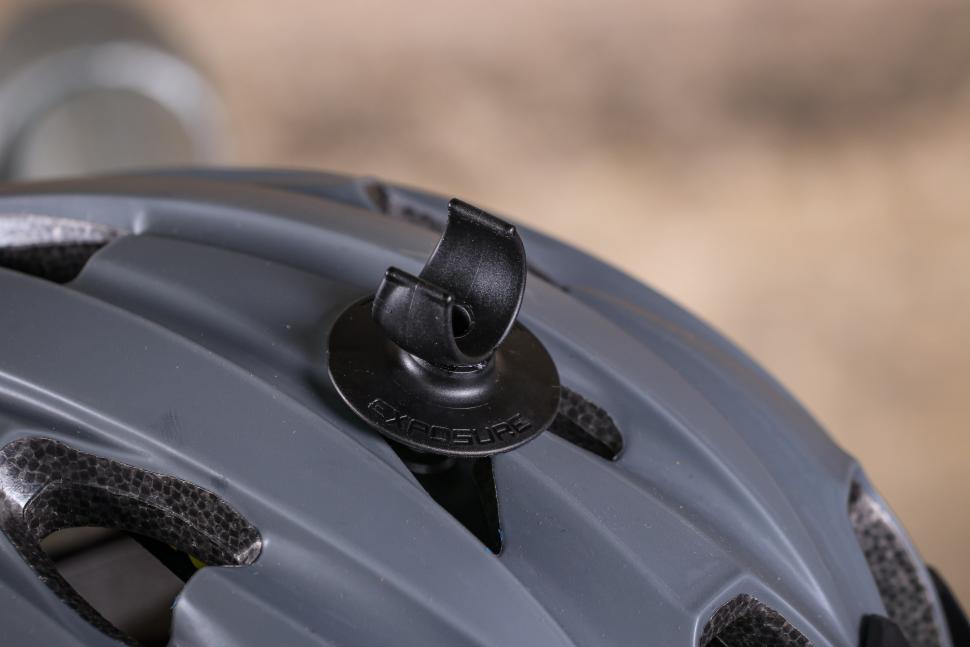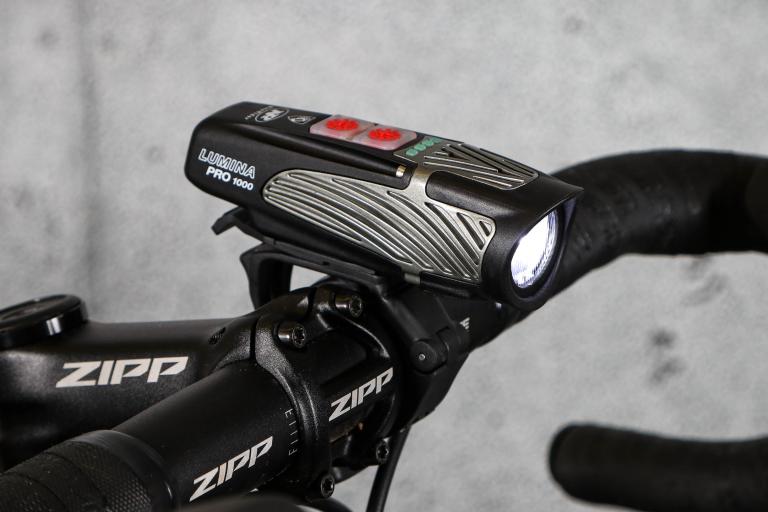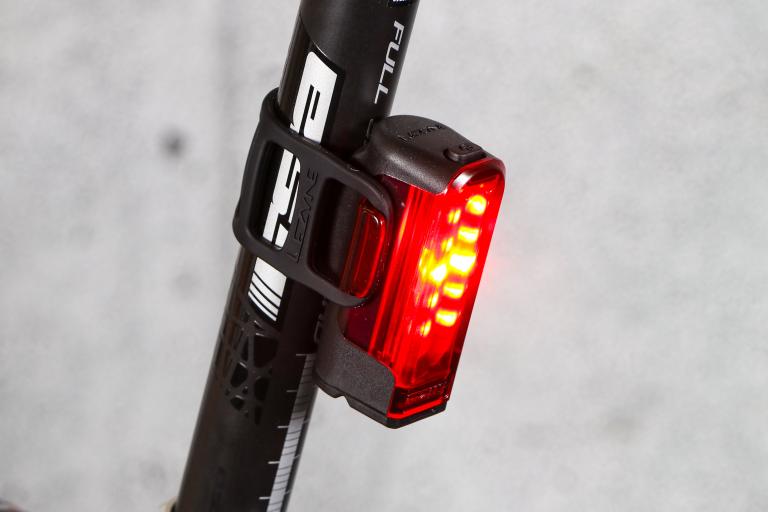- News
- Reviews
- Bikes
- Accessories
- Accessories - misc
- Computer mounts
- Bags
- Bar ends
- Bike bags & cases
- Bottle cages
- Bottles
- Cameras
- Car racks
- Child seats
- Computers
- Glasses
- GPS units
- Helmets
- Lights - front
- Lights - rear
- Lights - sets
- Locks
- Mirrors
- Mudguards
- Racks
- Pumps & CO2 inflators
- Puncture kits
- Reflectives
- Smart watches
- Stands and racks
- Trailers
- Clothing
- Components
- Bar tape & grips
- Bottom brackets
- Brake & gear cables
- Brake & STI levers
- Brake pads & spares
- Brakes
- Cassettes & freewheels
- Chains
- Chainsets & chainrings
- Derailleurs - front
- Derailleurs - rear
- Forks
- Gear levers & shifters
- Groupsets
- Handlebars & extensions
- Headsets
- Hubs
- Inner tubes
- Pedals
- Quick releases & skewers
- Saddles
- Seatposts
- Stems
- Wheels
- Tyres
- Health, fitness and nutrition
- Tools and workshop
- Miscellaneous
- Buyers Guides
- Features
- Forum
- Recommends
- Podcast
£69.95
VERDICT:
As a 'to be seen' helmet light, the Link Daybright has plenty of power, is tough, versatile and nicely designed
Weight:
59g
Contact:
At road.cc every product is thoroughly tested for as long as it takes to get a proper insight into how well it works. Our reviewers are experienced cyclists that we trust to be objective. While we strive to ensure that opinions expressed are backed up by facts, reviews are by their nature an informed opinion, not a definitive verdict. We don't intentionally try to break anything (except locks) but we do try to look for weak points in any design. The overall score is not just an average of the other scores: it reflects both a product's function and value – with value determined by how a product compares with items of similar spec, quality, and price.
What the road.cc scores meanGood scores are more common than bad, because fortunately good products are more common than bad.
- Exceptional
- Excellent
- Very Good
- Good
- Quite good
- Average
- Not so good
- Poor
- Bad
- Appalling
The Exposure Link Daybright is a secondary helmet light that adds 360-degree visibility and is great for being seen in heavy traffic. Designed and made in the UK, build quality is exceptional, it's very tough and run-times are reasonable bearing in mind its size and two LEDs.
- Pros: Great build quality, secure clamp, plenty of power for being seen
- Cons: Not easy to operate while riding, operation itself takes a bit of learning
The Link Daybright is the little brother of the £85 Link Plus Daybright that Liam reviewed here. Functionality is exactly the same, but the Link Daybright's run-times are exactly half those of the Link Plus Daybright because of its smaller battery. Output is also slightly lower.
> Find your nearest dealer here
I would say that as a secondary light for adding dimensionality to your visibility, for being seen rather than to see by, the basic Link does the job and is the one I would go for. Because it shines directly into other road users' eyes, since it follows the direction of your head, a blindingly powerful front light isn't necessary, and is even a nuisance. The Link is also lighter than the Link Plus, and of course it's cheaper.
I won't repeat everything Liam said, but regarding ease of use when it's in place on the helmet, there's the same issue: the power button, which also cycles between modes, isn't the easiest to operate in thick gloves. It doesn't feel prominent enough and can be easy to miss. In thinner gloves and with bare hands it's easy to find. The simplest and safest way is to start it before you set off.
Usability
As for the modes themselves, there are seven for each of the three power levels. You select a power level by holding down the power button and waiting for flashes: one for High, two for Medium and three for Low. When you've selected your power level you can cycle between seven modes, combinations of steady/flashing, front on/rear off, rear off/front on and so on.
Unless you are familiar with Exposure lights' operation, it can take a bit of learning. It's especially easy to forget whether it's one flash or three for High. The etched graphics on the casing, which give you the run-times of the various modes, don't tell you this as they do with the Exposure TraceR Daybright rear light. Fortunately the light's memory function was better than mine: you can just set your preferred power level and mode, use the light, and the next time you switch it on it returns to the setting you last used.
The front light isn't powerful enough to see by – you'll need an output of upwards of 300 lumens for that, and the Link Daybright supplies a maximum of 100. The rear, at 35, is bright enough, though. To me it doesn't look any dimmer than the 75-lumen Exposure TraceR – both are equally blinding if you look directly at them (not advisable).
> Buyer's Guide: The best 2019/2020 front lights for cycling
> Buyer's Guide: 17 of the best rear lights for cycling
The clamp holds the light securely. However, I couldn't use it with an Abus Gamechanger aero helmet, which didn't have a vent in the right place, and using it with a Bontrager Velocis it clamped over the MIPS liner, preventing it from sliding as it is designed to do in an impact.
You can angle the light once clipped into the clamp, but as both lights won't always be visible from all angles, particularly if you're in a tuck and your head is low, it's essential to also use fixed lights.
Battery life is between 1:30 and 24 hours – meaning if you have both lights on constant/high you're going to burn through the charge very quickly. As a secondary light, low power flash for both LEDs gets you 12 hours, which covers a week of commutes and a weekend ride for most of us.
Value
Exposure is arguably the leader in helmet lights and certainly makes some of the best quality and most aesthetically pleasing ones. The Cateye Volt 400 Duplex is slightly more expensive at £69.99 and has a higher output, but it's not as neat a solution, either in terms of its clamp or the light itself.
The Exposure Link Plus Daybright already mentioned costs £85 and does exactly the same as the basic Link but is bigger, more powerful and has twice the run-times.
Verdict
As a 'to be seen' helmet light, the Link Daybright has plenty of power, is tough, versatile and nicely designed
road.cc test report
Make and model: Exposure Link Daybright
Size tested: 100 lumen front, 35 lumen rear
Tell us what the light is for, and who it's aimed at. What do the manufacturers say about it? How does that compare to your own feelings about it?
Exposure says: "Helmet mounted combo light with 360° visibility in a prominent position with high power and long battery life. Versatile options of either single or double LED illumination with constant or pulse variations within those options. DayBright flash pattern to cut through distractions of busy roads to alert other road users."
Tell us some more about the technical aspects of the light?
Exposure lists:
LED Configuration: 1 x White XPG3 / 1 x Red XPE-R
Lumens: Max White 100 / Red 35
Battery: 700 mAh Lithium Ion
Runtime: 1.5 - 24 hours
Rechargeable: Through Case USB
Charge Time: 4 hours
Weight: 45g
Material: Anodised 6063 Aluminium
Water Resistance: IP6
Length: 70mm
Head Diameter: 29mm
In The Box: Link Daybright, Helmet Mount, Micro USB Charge Cable, QS Guide
Rate the light for quality of construction:
9/10
I am a big fan of Exposure's machined, anodised aluminium casings and tough lenses – and they're made in Britain.
Rate the light for design and ease of use. How simple was the light to use?
9/10
Exposure system of changing between power levels by holding the power button down and waiting for the flashes works very well and is foolproof, as long as you remember that one flash means High and three means Low and not the other way round.
Rate the light for the design and usability of the clamping system/s
8/10
The clamp is easy to fit and very secure. There are two plastic bolts in the box for different depths of vent. However, it won't work with aero helmets (an Abus Gamechanger, for example, which doesn't have a suitable vent to clamp) and it restricted the MIPS liner of a Bontrager Velocis.
Rate the light for waterproofing. How did it stand up to the elements?
9/10
The silicone band around the power button and the USB port works fine – no issues with this or any other Exposure light I've used with this system.
Rate the light for battery life. How long did it last? How long did it take to recharge?
9/10
Pretty much as Exposure claims. The charge time of four hours is long compared with some other lights that only take two hours, but it's not unreasonable.
Rate the light for performance:
9/10
Very bright indeed, with a good choice of modes – some might say too many to scroll through.
Rate the light for durability:
9/10
Very tough aluminium case will last for years, and Exposure offers spares and servicing.
Rate the light for weight:
8/10
Not the very lightest, but the metal case is going to be heavier than plastic.
Rate the light for value:
7/10
It's quite expensive, but you're paying for a high-quality product that's been designed and made in the UK and that will last for years, which ups the value. For what it is and what it does, it's well worth the money and I would choose this over the more expensive Link+ Daybright, which is longer and heavier and costs £85.
Tell us how the light performed overall when used for its designed purpose
As a secondary helmet light, it performed exactly as it should.
Tell us what you particularly liked about the light
I liked the construction, the functionality, the brightness and the extra dimensionality and therefore confidence it gave me when I was riding with it.
Tell us what you particularly disliked about the light
As with the more powerful Link Plus, it's not so easy to operate the power button with gloves on when it's in place on top of the helmet.
How does the price compare to that of similar products in the market, including ones recently tested on road.cc?
The price is relatively high, as with the other Exposure lights, but you're paying for a high-quality product that's been designed and made in the UK and that will last for years. It's cheaper than the Exposure Link Plus Daybright which costs £85, but that offers more power and double the run-times. The Cateye Volt 400 Duplex is slightly more expensive at £69.99 and has a higher output, but it's not as neat a solution, both in terms of its clamp and the light itself.
Did you enjoy using the light? Yes
Would you consider buying the light? Yes
Would you recommend the light to a friend? Yes
Use this box to explain your overall score
For adding all-round visibility, the Exposure Link Daybright does an excellent job without being antisocially bright. It's slightly more complicated to use than other Exposure lights, especially as it's missing a bit of settings guidance on the casing. The trademark machined aluminium case gives it an unbreakable feel and the price is fair for the high-quality, UK-made product that it is.
About the tester
Age: 50
I usually ride: Racer Rosa custom alu My best bike is: Colnago Master Olympic
I've been riding for: Over 20 years I ride: Most days I would class myself as: Expert
I regularly do the following types of riding: time trialling, commuting, touring, club rides, sportives, school run on a tandem







Cycling infrastructure does not force drivers to break the law, drivers are the reason they break the law, no one else.
Ah but taking pictures of things to defy the man (avoid a fine) is righteous. Taking pictures of people to grass on them to the cops (perhaps...
But getting paid for it is the very definition of professional....
Never had a Shimano QR fail on me. They just work. And the top end ones look good too....
If you're only looking at the guy in front of you then you're going to crash whatever brakes you have, you need to look beyond them to anticipate...
As a woman, this works great for me! My chain broke once, and a kind guy stopped with a chain breaker and sorted it all out for me. We stopped at a...
Same. I also have gone through a bunch of their tyres, and only the extralight disappointed (torn sidewall) but the standards are fantastic....
thanks for the ideas....
Indeed - but it's no more inconsistent than our current road design - very often UK high streets are "for shopping" and also a busy through route....
If you ask the world's leading economic commentators how many people have been rescued from abject poverty by capitalism the average answer would...